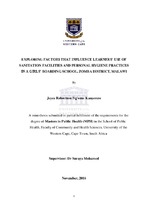| dc.description.abstract | Background: Millennium Development Goal 7 was to ensure environmental sustainability by aiming to halve the proportion of people without sustainable access to basic sanitation and safe drinking water by the year 2015. The 2015-MDG Report estimated that the use of improved sanitation rose from 54% to 68% globally, but the target of 77% was not met, and that implies slowing the progress in the health and education sectors. Although Malawi has made significant progress in increasing access to safe water and improved sanitation in comparison to other Sub-Saharan African countries, disparities in improved water supply and sanitation within Malawi remains a challenge. In Malawi, only about a quarter of all schools have improved latrines with a ratio of one latrine for every sixty learners. While the water and sanitation situation in primary schools of Malawi is reported to be making progress, such progress remains unreported in secondary schools. Aim: The purpose of this qualitative study was to provide insight on the water and sanitation situation in secondary schools by understanding factors that influence learners' use of the water and sanitation facilities and personal hygiene practices in a girls' boarding secondary school in Zomba District, Malawi. Methodology: This study employed a descriptive qualitative study design using individual interviews, focus group discussions (FGDs) and observations. A purposive sample consisting of 12 learners participated in two FGDs, while individual interviews were conducted with 6 prefects, 2 teachers responsible for sanitation at the school and 1 matron. The FGDs and individual interviews were targeted at exploring these participants' perceptions, experiences, challenges faced in the use of water and santation facilities and perceptions of appropriate interventions to improve hygiene practices and utilization of sanitation services. Thematic analysis was used to analyze the data. Findings: The findings indicate that there were several factors that influenced learners' use of water and sanitation and their hygiene practices at the school. One of the main challenges was the irregular supply of safe water by the Southern Region Water Board which meant that alternate sources of water, which was not always potable, had to be used instead. Poor water and sanitation infrastructure and facilities including lack of privacy in shower cubicles and the poor condition of the incinerator that is meant for disposal of sanitary pads were other challenges facing the learners. There were also insufficient toilets and shower cubicles for the number of learners at the school. A good number of learners knew the importance of hand washing for their personal health at school, but limited accessibility to running water compromised their hand washing practices and personal hygiene including menstrual hygiene. Conclusion: It can be concluded that the challenging factors occur at the macro, meso and micro levels but more importantly that these levels are interrelated and impact on one another, emphasising the complexity of the water and sanitation situation in the study school, but could most likely also be the situation at other schools in Malawi. Therefore multi-level interventions will have to be put in place to address these challenges. Recommendations: The present study recommends that at macro level the Department of Education should provide an enabling environment and political will to facilitate development of a multi-sectoral approach that would complement the school operation rules to improve the adequacy of the water and sanitation facilities and hygiene practices. In addition, the Southern Region Water Board should ensure a reliable supply of safe water to the school and provide better infrastructure of piped water. At meso level (school organisational level), the school management should take more responsibility for maintaining the infratstructure. In addition, the school-board, the school management and parents'-teachers' association and learners should form a committee to discuss and implement strategies that would enhance the learner's use of water and sanitation facilities at the school and ensure their privacy and dignity. At micro level, the school, the communities including families and religious leaders should encourage personal hygiene practices repeatedly amongst everybody. | en_US |

